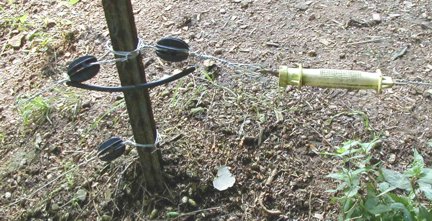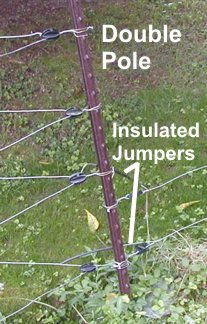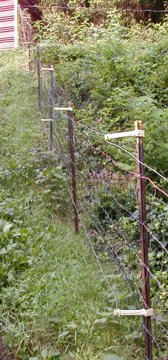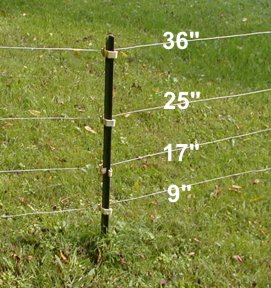Fencing
I was once told when I first started out in goat keeping that "no fence would hold a goat". I found this to be totally untrue. How well your fence "holds" your goats depends on how well you treat them and how well they are fed. My fence is more to keep predators out than to keep my goats in. I use electric fence and it goes through some wooded area. There have been times when a tree has fallen across the fence, breaking it. The goats gather around the fallen tree to feast, but none leave the "fenced" area, even though, at that time, there was no longer a fence. Why? They have learned the fence line, they respect it, and they also have no desire to leave. My garden is right next to the goat area and it was surrounded for many years with just electric fence. When I worked in the garden, the goats would come and wait for me to throw them some goodies, but they never once broke through the fence to get to the garden. I finally had to put "real" fence around the garden, not because of the goats, but because of the chickens insisting on digging up my newly planted raised beds.
There are many ways to build fences and you will find the way that best suits your needs. My fencing consists of just electric wire for the does (and wethers) and woven wire with two strands of electric for the bucks.
Electric Fence:
Electric fencing is a psychological barrier; not a physical barrier. It can work very well if the fence is set up and used properly. The most important thing about this type of fencing is to put it up right and make sure that the first time the animal touches the fence he/she gets a jolt they will never forget. Goats are smart and may only need to touch the fence once to learn what it is all about.
I like electric fencing because: it is easy to set up, even for a novice (like we were when I put up my first fence); it is flexible, in that you can move it or easily add new area if you wish; and it is also very easy to repair. I, personally, have never had a problem with my goats going through this type of fence. But keep in mind, I supply our goats with a life they have no desire to leave.
What kind of wire?
I like using aluminum wire (17 gauge). This type is a little more expensive than steel wire, but is much better in three respects: 1) It conducts electricity better; 2) It never rusts; 3) It is so easy to work with and bend that you can use just your bare hands. This last reason is reason enough if you ever do a lot of fencing or need to repair a break in a hurry.
I use four stands of wire (all wires are "hot"):
- The first wire is about 9" from the ground
- the second is about 17"-18" from the ground
- the third is about 25"-27" from the ground
- the fourth is about 36" from the ground
- If you really felt the need, you could put a fifth wire at 4 feet (we don't)
What kind of fence charger?
You need a good, strong "fencer" (the electric fence "charger"). When they say on the box how many miles the fencer charges, they list the greatest length of one strand under the absolute most ideal situations. When buying a charger for your situation, get at least the next one up from what you really think you need; better yet, get one you think is way more than you really need. Remember that if you are using four stands of wire, you will be going around your property four times, so the length the fencer has to charge is four times the length of your fence. I have about 7 acres fenced and we use a 2 Joule Low Impedance fencer that is rated for 50 miles (we wouldn't use anything less). Don't get a fencer just rated for pets; you want to look at the bigger fencers rated to keep out predators (and keep in goats). Our fencer gives a 6000 volt pulse jolt: strong enough for predators, yet safe enough that it will not physically hurt a week old goatbaby (but it sure will give him a jolt that teaches him to stay away from the fence). I want to make absolutely sure that anyone who touches the fence will get a kick they will never forget.
I use a plug in fencer; I tried a solar fencer and very disappointed with the results. (But then again, I do not get a lot of sun here) I found I couldn't rely on it to hold a good strong charge and the pulses were longer apart, making it easier to touch the fence and not get juiced (not what you want). You want a good fast pulse to make your fence more effective. If your fence is in a wooded area, branches will fall on the fence. If you are using a solar fencer, it will be quickly drained into the branch and/or earth, where as a plug in, will always have some power.
Grounding
It is very important that you ground your fence correctly. Read and follow the instructions that come with your fencer on how to properly set up an electric fence.
Safety
Do not worry that you goats will suffer any great injury from a properly working electric fence. It really startles you more than hurts. One week old babies hit our fence and give a great yell, but they are not physically harmed.
Putting up the fence
I followed the instruction I read about putting up electric fence, but also "learned by doing". My land is extremely rocky and a nightmare to dig, so instead of digging post holes, I use 6 foot t-posts driven with a t-post driver. Where I have corners, I came up with the idea of "double posting". You drive one pole in with the t-post driver, and then you drive another post in, right next to it with a sledge hammer. It is hard work, but still easier than digging a hole. The posts are then bound together using wire. This makes for a very good "short cut" corner.
See the photos below for examples of how I put up my fence below
Electric fence problems:
Goats going through:
I have never had any of my adult goats go through my fence. Yes, on occasion, a young kid might get through, but they quickly learn about the fence and usually once is it for ending up on the wrong side of the fence. I have heard of people having trouble with their goats going through the new electric fence once it is up. There is the possibility that your goats may have no idea what an electric fence is, and because the wires are so thin, they just, out and out, do not see the fence. It this case using one line of poly tape about a foot or so from the ground, may be just the ticket to get them to see, and notice, the fence. Once they see it, and touch it, that should be all that is needed to keep them in.
Woven wire + electric - Fencing for Bucks :
You must have tougher fencing for bucks. A buck will go through electric fence (just a psychological barrier) and so also needs a physical barrier. For our bucks I use woven wire "field fencing" AND electric. The electric is used to keep the bucks from rubbing on and/or standing on the fence and thus knocking it down (which they will do). One strand of electric wire is placed on the buck side of the fence, half way up. The other stand is place along the top of the fence. This has worked very well for me.
If you choose to use Woven wire or something similar for your does, you should still use the two strands of electric to save your fence from getting knocked down or climbed on and over.
Other types of fencing
You do not have to use electric fence for goats; you should use whatever is best for your particular situation. I give a lot of information on electric and not other types of fencing here because we use electric fence and this what I have experience with.
If you do not use electric fence, be ware that goats WILL climb on, and rub on, a non-electric fence and tend to push it over if not well constructed. Some people use cattle panels for fencing which can work quite well in a situation where the land it flat.
Fencing for security
Interestingly, the function of most fences is not to keep something in, but to keep something out.
If you have any kind of security issue, you may want to "beef up" your fence. My doe area borders the road. Here, I use the same sort of fencing I use for the bucks (Woven wire + electric). This is not because we worry about the goats going through the fence and getting on the road, but because our neighbors have dogs they let run loose and we want extra security for our goats from these dogs.
Also, keep in mind keeping out unwanted humans. Most humans are not fooled by the psychological barrier of the electric fence, because of this you could risk mischief and/or theft. I have personal experience from this. I never once thought someone would break my electric fence, come into my barn and steal one of my goats, but they did. I cannot begin to tell you how this effected me emotionally. As a result, I have learned not to trust everyone and have really "beefed up" the fencing in my gate and barn area (adding "cattle panels", woven wire, etc).
This is the gate to my buck area. It is hung using the special hardware they make for t-posts. It has worked fairly well and I would recommend it for use with does or wethers, but if I did this again, for bucks, I would probably sink wooden posts. The bucks used to stand on, and stick their head through, the gate, but I covered it with hardware cloth, which has now made it impossible to stand on and so the gate is holding up much better. |
|
|
|
 An example of a simple "gate" (not used often). The pole is a double pole. The same wire use for the electric has also been used to attach the insulators. This attaching wire it not "live". |
|
 Electric fence meeting the garden fence. Along the garden you see green garden fencing plus two strands of electric to keep the goats from pushing on the fence. The corner pole is a double post. Note the gate is hung on wooden posts at the end of the garden. |
 A tight corner where the goat fence meets the front yard fence. I use electric in my front yard to keep in my Basset Hound. Because she is short and can't jump, we only need two strands of wire in her area. |



